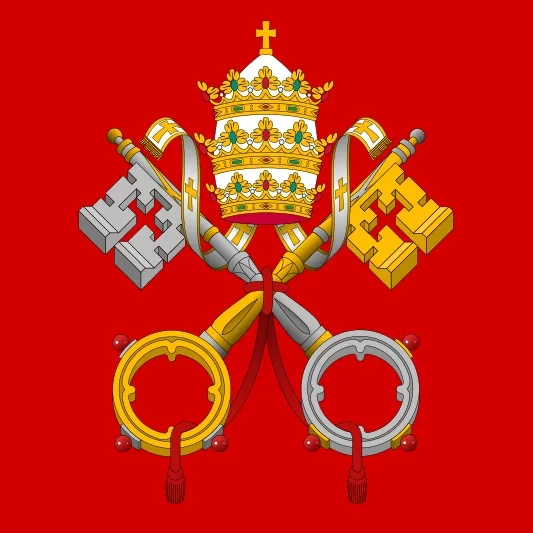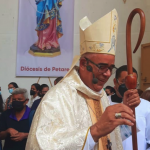Black Elk, daughter Lucy Black Elk and wife Anna Brings White. / Credit: Public Domain
Detroit, Mich., Dec 10, 2023 / 07:00 am (CNA).
Nicholas Black Elk, an Oglala Lakota Sioux warrior, visionary, and Catholic catechist, is known worldwide but has been misunderstood for decades, according to two Jesuit priests who have emphasized Black Elk’s enduring Catholic faith as his canonization process unfolds.
First published in 1932, the book “Black Elk Speaks” became especially popular in the 1960s counterculture when many Americans and Europeans were searching for spirituality distinct from Christianity. The acclaimed book is based on conversations the Sioux holy man had with Nebraska poet John Neihardt. Black Elk (1865–1950) spoke in Lakota and was translated by his son, Ben Black Elk, whose words were recorded in shorthand. The book has appeared in several editions for decades to acclaim.
However, it has been criticized by the Lakota as well as by scholars.
Indiana University professor Raymond DeMaille, for example, questioned Neihardt’s faithfulness to Black Elk’s words. Later, Nebraska University Press addressed the controversy by publishing an edition titled “Black Elk Speaks: as told through John G. Neihardt (aka ‘Flaming Rainbow’).”
Father Michael Steltenkamp, SJ, an anthropologist and parish priest, has written several books and journal articles about Black Elk and has prepared biographical materials for the canonization process. For Steltenkamp, Nicholas Black Elk is a model for American Catholics.
Steltenkamp told CNA that “Black Elk Speaks” really only chronicled the first 25 years or so of Black Elk’s long, momentous life. Referring to its author, Steltenkamp said: “Neihardt reports that Black Elk was born in the Moon of the Topping Trees (December). In fact, Black Elk was born in the summertime, but he used Dec. 6 as his birthdate because that was the day he was baptized” in 1904.
“In his words, not mine, not some fundamentalist’s words,” Steltenkamp said, “he was born again.”
Dec. 6 is the feast day of St. Nicholas and was thus the name Black Elk took as he began a new life, Steltenkamp said.
A series of visions
Black Elk was born on the plains of Wyoming and from an early age had mysterious visions that garnered respect among Lakota medicine men and tribal healers. Hardly more than a boy, and before his conversion, he participated in the Battle of the Little Big Horn in Montana, where he scalped a soldier. Col. George Armstrong Custer and his men were killed there in 1876. Black Elk’s cousin, Crazy Horse, was the famed Lakota war chief there.
The 1870s saw the influx of white settlers on the Great Plains and the extermination of millions of bison, which was met with armed resistance by Native Americans. The U.S. Army fought the Sioux and other native peoples who were gradually worn down by the war; forced into reservations; died of exposure, starvation, and disease; and made dependent on government handouts.
But there was interest in the eastern United States and Europe in the vanishing Native Americans.
Black Elk joined William Cody’s tour of Europe as part of Buffalo Bill’s Wild West show and even gave a command performance for Queen Victoria as part of her 1887 golden jubilee. The monarch solemnly bowed to the Native Americans in a sign of respect shown only to fellow rulers, Steltenkamp said. Black Elk visited European cathedrals where white men worshipped. He understood that not all whites were evil.
“He had a much more ecumenical, rather than a tribalistic, or parochial, Christian vision,” Steltenkamp said. “He was universal in his preaching. He was Christ-like.”
The crisis for Native Americans on the plains produced a spiritual movement known as the Ghost Dance and swept through the West in the late 1880s, giving them hope that whites would leave, the bison herds would return, and the old way of life would be renewed by an awaited savior. But the army feared the Ghost Dance would embolden Native American resistance.
Black Elk had a series of visions during a dance — more than a decade before his conversion — in which he saw a man “with wounds in the palms of his hands.” He said: “Once more, I saw the sacred tree all full of leaves and blooming. Against the tree was a man standing with arms held wide in front of him. I looked hard at him and could not tell what people he came from. He was not ‘wasi’chu’ [non-Indian] and he was not Indian. His hair was long and hanging loose… his body began to change and became very beautiful with all colors of light… He spoke like singing: ‘My life is such that all earthly beings and growing things belong to me. Your father the Great Spirit has said this. And you too must say this.’”
Steltenkamp said: “He sees this figure calling all people to the flowering tree of ‘Wakan Tanka’ (‘Great Spirit’). That is the resurrected Jesus. He saw all humanity under a flowering tree and the flowering tree as a symbol of the Christian life of all people. I am quoting his daughter, Lucy, on that.”
Serving his people as a healer and holy man, Black Elk rescued the wounded at the Wounded Knee Massacre in 1890, where the army tried to disarm the Lakota, and killed at least 300 — including women and children — on the Pine Ridge Reservation in South Dakota. Native American resistance was effectively at an end. Red Cloud, a Lakota leader, convinced Black Elk to stop fighting and stay at the reservation.
Red Cloud later invited Jesuit missionaries to the Pine Ridge Reservation because of his trust in the Jesuit priests, whom the Lakota called “black robes.” At his request, a Catholic school, which is still in operation, was established there.
As for Black Elk, he married Katie War Bonnet, a convert, in 1892, and their three children were baptized Catholics. In 1903, Katie died. Two years later, after his own conversion, Black Elk married Anna Brings White, who was also Catholic. Among their children was Lucy, who befriended Steltenkamp in the 1970s. Their relationship grew so close in the 1970s that she called Steltenkamp “grandson.”
Black Elk’s Catholicism
Steltenkamp said Black Elk’s Catholic faith only grew after his baptism. He became a catechist at the Pine Ridge Reservation, taking on for nearly 50 years duties resembling those of modern permanent deacons. He preached the Gospel, taught the basics of the faith, and baptized the dying. Steltenkamp said that Black Elk was “really committed to this 24-hours-a-day ministry: a vocation.”
In a 2013 article in U.S. Catholic Historian, Steltenkamp wrote that the “Encyclopedia of Indians” described Black Elk’s Catholicism as calculated in order to “appease his oppressors.” But according to Steltenkamp, Black Elk’s nephew, Pat Red Elk, said that whoever described Black Elk this way “sure didn’t know Uncle Nick.”
Father Joseph Daoust, SJ, who serves at Pine Ridge, said of Black Elk: “He wanted to help his people get the faith which had helped him. He was a man of hope in very difficult times. These were prisoner of war camps and they were deprived of the means of taking care of themselves.”
“Black Elk had credibility,” Daoust continued. “He was used as a missionary even in Wyoming to reservations where they don’t speak Lakota. He didn’t know Arapaho or Shoshone. But he was considered a holy man by them.”
“The memory of him as an old man was of seeing him every Sunday walk from the general store to St. Agnes Church in Manderson, South Dakota, on the reservation, with his friend John Lone Goose. Black Elk began praying the rosary, ‘Hail Mary full of grace,’ and John responded, ‘Holy Mary, Mother of God,’ and they would finish the rosary by the time they reached the church. They would remember Black Elk always had a rosary in hand,” Steltenkamp said.
Another example of his devotion, Steltenkamp said, was that despite advanced age and arthritis, Black Elk would always insist on receiving the Eucharist on his knees at the altar rail, getting help from family to genuflect. During an annual retreat for catechists during Holy Week in 1923, Black Elk approached a Jesuit priest with a “very worthy resolution: ‘We catechists resolve never to commit a mortal sin.’”
In a video documentary titled “Walking the Good Red Road,” sponsored by the Diocese of Rapid City, South Dakota, Steltenkamp said: “I can see why Black Elk and the Jesuits got along. Because part of the mystical tradition of the Jesuits is to find God in all things. How do you find God in the midst of tragedy and tears or loss? You have to seek God in that.”
The Jesuits developed a unique catechism for use among the illiterate on the American Plains. In the video, Steltenkamp described the “Two Roads Map”: a chart with colorful depictions of the Old Testament and the birth, ministry, death, and resurrection of Christ. A black road lead to perdition, while a red road lead through the Church to salvation.
”Black Elk used the Two Roads Map for 30 years and taught many generations of kids and older people what Christians call salvation history … He said, ‘I saw my vocation as leading my people from the Black Road to the Red Road,’” Steltenkamp said.
“It’s a lot of hogwash that Black Elk didn’t live his faith sincerely. His daughter wanted to make it clear that Neihardt’s depiction of him as a 19th-century figure did an injustice to his life as a whole,” Steltenkamp emphasized.
Canonization process
In an interview with CNA, Daoust said Black Elk is recognized among the people of Pine Ridge as a holy man in both the Lakota and Catholic senses.
“We didn’t run into any opposition to canonizing him, especially among his relatives,” Daoust said, adding that a commemorative Mass is said every year at the church in Pine Ridge on Aug. 17, Black Elk’s death date.
“There are some descendants who are not Catholic, but not anti-Catholic, but who believe the Church was part of colonization, who say this is an honor, and ‘go ahead and do it to my grandpa,’” Daoust said.
“His process of conversion was gradual,” Daoust said, adding that not “everything before his conversion was holy. Catholics should know he was a faithful Catholic, a missionary Catholic, somebody who went to reservations with the Jesuits and spoke very well of Jesus Christ and the faith.”
“He was a great model of being both Catholic and Lakota,” Daoust said, noting that Black Elk continued some Lakota practices that are not at odds with Catholic teaching. As for any lingering doubts about Black Elk’s Catholic identity, Daoust pointed out that even St. Ignatius Loyola — founder of the Jesuits — was a soldier who defended his country from outsiders.
Steltenkamp said that Nicholas Black Elk is now honored as a Servant of God and the cause for his canonization is now before the Dicastery for the Causes of Saints at the Vatican.











